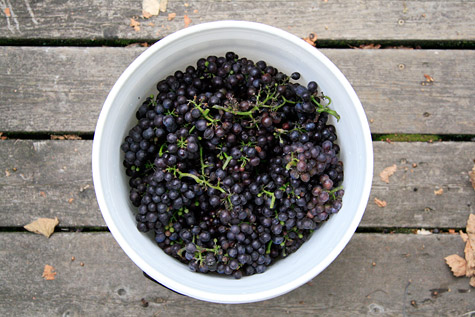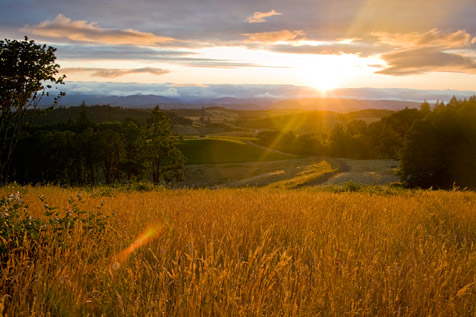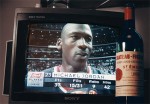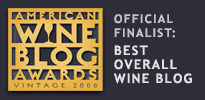Archive for the 'Vino' Category
More like Prudy, please
A nice, if not entirely deep profile in Slate of humble viticulturist Prudy Foxx, who relies as much on intuition and experience as science in managing world-class vineyards. Says one of her clients,
She’s just one of those people with great intuition, and in grape growing, that’s so important. It’s so refreshing to walk the vineyards with her. She has all the botanical and scientific knowledge, but it is the intuitive side that is so important to growing anything. It is in her veins.
Amen.
No commentsAbout this supposedly crappy vintage

I don’t have any skin but grape skins in the game, so it’s been interesting to watch the pitched battle unfolding to define this vintage — before its wines have even finished fermenting, much less transmogrified into something someone could actually taste and evaluate.
On the one hand, there’s everything you’ve been reading in the media, or heard whispered by wine-wags in restaurants, wine shops and tasting rooms: the vintage is a complete wash. Low crop yields, waves of botrytis and powdery mildew, grapes wheezing toward ripeness (if at all), and the coup de grâce, ravenous birds. All have pounded the industry with the most challenging and grim harvest in decades.
On the other hand, you’ve got winemakers who’ve actually been out there, working the vines and the fruit. The ones I’ve talked to are stoic, but guardedly optimistic, arguing that the cooler weather has produced beautiful, elegant wines that truly express the uniqueness of Oregon – for the first time in years.
Keep in mind, of course, that their livelihood is utterly dependent on consumers’ preconceptions about a vintage. If a consensus develops that a vintage is great, it’ll fly off the shelves; but if the buzz is otherwise — or worse, that it’s a disaster — they’ll have trouble even moving it out of the bottling room. Would you fan the flames of the latter if your income depended on it? I didn’t think so.
So who’s right?
I think one answer may lie in the bucket you see above. That’s the sum total of the Giraud “estate” harvest from my back yard, about 25 pounds. Before the rains bore down a week or so ago, I frantically clipped what fruit I could salvage: probably half unripe and mildewed, half passable, and all told, 20 brix. Without some sugar, that would produce wine a shade above 11% alcohol, fine for Riesling but anemic for Pinot Noir.
So there you go: proof. The buzz is right, the vintage sucks.
But not so fast. I’m a rank, drooling amateur when it comes to farming grapes. Most years I’m lucky even to get a good crop of mildew, much less viable, fermentable fruit. That I got vaguely healthy grapes as high as 20 brix this year is nothing short of a miracle, in fact.
So if a yahoo with a hoe can do that, what do you think someone with years of training and experience can do? Take, for example, the fruit we brought in from Oracle Vineyard in the Dundee Hills, farmed by people who actually know what they’re doing. Totally clean, exceptional flavor, vivid acidity. Its numbers look great, and well within the ballpark of ideal for Pinot Noir.
I’ve heard a lot of that around the Valley. Sure, some horror stories, and certainly low yields, a tsunami that will roll dire economic consequences toward the shores of those without deep enough pockets. But at the same time, tales of great flavors and a chance to make a truly Oregon Pinot Noir, one balanced on the razor’s edge of ripeness where the varietal truly comes alive.
So that’s my read. In the hands of people who know what they’re doing — and didn’t panic — this vintage is going to produce some disarmingly elegant wines. Will Robert Parker anoint them with high scores? Unlikely. It’ll be nowhere near the syrah-like California style he favors. But will it earn high marks from those smart enough to snap up the tragically few that make it to market? Oh, yeah.
In the end, maybe what’s scariest about this vintage is that it’s kind of a ticking time bomb for less talented winemakers and growers. Everyone’s reputation will probably survive the year, but when 2010 wines hit the shelves, there will be nowhere to hide: the true measure of talent will be unflatteringly revealed in the glass.
9 commentsReprint: Crush Time
One more chance to make the perfect wine
[ Since we’re in a harvest mood, I thought I’d reprint this article I originally wrote for Imbibe Magazine in 2006. It’s a decent introduction to all the decisions winemakers need to make leading up to harvest. Whether we’ll make the same ones — or as well — remains to be seen, of course… ]
Maybe today is the day.
It’s mid-morning in Oregon, late in September, and winemaker John Paul is winding his beat-up van down a familiar dirt road through hillside vineyards, wondering how the grapes will taste today. At the edge of autumn, the sun still low in the sky, the leaves on the vines are a blaze of vermillion and gold. Outside the window, the air feels warm and clean on his hand, but there’s a brittle edge to it that only confirms the seasons are changing and harvest is near.
Like an expectant parent, Paul been feeling these and other faint contractions for weeks as the grapes arc toward ripeness. He knows the labor of crush could start any day.
Maybe today is that day. The day crush begins.
Read the rest of the article: Read more
No commentsThe View from Oracle
 Looking west from the lower, still-to-be-planted part of Westrey‘s Oracle Vineyard
Looking west from the lower, still-to-be-planted part of Westrey‘s Oracle Vineyard
Just Sip It
[ In honor of the new NBA World Champions, here’s a reprint of a column I wrote back in the Jordan era about basketball and wine. Check out the stars I mention — now that’s old school, baby! ]
 A dark arena surrounding a gauzy, spotlit court. Everything seems slow, supercharged and saturated, almost dreamlike. Michael Jordan, lean and crouched, is facing off against some hapless guard as the ref tosses the ball skyward. Cut to a tight shot of the ball rising to the height of its arc until Jordan is just about to touch the ball. There’s the woody sound of a cork being coaxed out of a bottle, and then freeze-frame and echoy silence — maybe the distant clink-clink of full bottles — as everything stops, hanging for a moment.
A dark arena surrounding a gauzy, spotlit court. Everything seems slow, supercharged and saturated, almost dreamlike. Michael Jordan, lean and crouched, is facing off against some hapless guard as the ref tosses the ball skyward. Cut to a tight shot of the ball rising to the height of its arc until Jordan is just about to touch the ball. There’s the woody sound of a cork being coaxed out of a bottle, and then freeze-frame and echoy silence — maybe the distant clink-clink of full bottles — as everything stops, hanging for a moment.
Just as we can’t stand it anymore, one last squeak explodes to the intercut sound and visual of a cork popping as Jordan smacks both the ball and the camera pace into motion. Music starts — maybe Hendrix singing Dylan’s line about businessmen drinking his wine — and Jordan flows up the court and takes to the air, all grace and knowledge, super-imposed with red wine poured super slow-mo, roiling into a glass as the camera tracks a 360 around it. As Jordan nears the rim a third image of a lowering bottle of wine is superimposed, touching the ground as the ball snaps the net. Fade all but the dramatically lit bottle, and super text:
“Domaine Dunquage. Red, white, and beyond…”
Didn’t see that one during the playoffs? Neither did we, but as we wandered into sports bars, asking after their corkage fee, we began to wonder why. What is it about sports in America that has made it so inhospitable for wine, and yet so welcoming for beer and other beverages?
Read more
An idle threat
American Blog Awards voting ends at midnight tonight (March 28th), so if you’ve enjoyed reading our scrappy little blog, please consider throwing a vote toward our quixotic quest for “Best Overall Wine Blog.”
Do it, or we’ll drink this wine. Oh. Okay, do it or we’ll drink this other wine. Uh…
Here’s the ballot. Thanks!
No commentsWining Children

Asimov posts this week on how, when, and whether to introduce minors to wine. Could it be that, as a place to learn about drinking, the family home beats the frat house?
“The best evidence shows that teaching kids to drink responsibly is better than shutting them off entirely from it,†he told me. “You want to introduce your kids to it, and get across the point that that this is to be enjoyed but not abused.â€
He said that the most dangerous day of a young person’s life is the 21st birthday, when legality is celebrated all too fervently. Introducing wine as a part of a meal, he said, was a significant protection against bingeing behavior.
What is the evidence? In 1983, Dr. George E. Vaillant, a professor of psychiatry at Harvard University, published “The Natural History of Alcoholism,†a landmark work that drew on a 40-year survey of hundreds of men in Boston and Cambridge.
Dr. Vaillant compared 136 men who were alcoholics with men who were not. Those who grew up in families where alcohol was forbidden at the table, but was consumed away from the home, apart from food, were seven times more likely to be alcoholics that those who came from families where wine was served with meals but drunkenness was not tolerated.
Put that way, it seems obvious, but the post is thought-provoking, and I’m not the only reader who thinks so. The Pour normally sees 30 or fewer comments per post; this one had over 300 in a day. Among them are plenty of anecdotes and arguments pro and con, including not a few sobering perspectives from alcoholics. This being the Interwebs, there’s also plenty of sanctimony, hysteria, anger, inapt analogies and rhetorical overreach—the Human Comedy as it plays out in comment threads.
Puritanism and hedonism are the yin and yang of the American Way, so drinking, and thinking about drinking, will always be good blog fodder. But reasonable people such as ourselves can draw a couple of modest conclusions from this particular go-round: to the extent that parents can influence teenage drinking by providing a model of appreciation over intoxication, they should; and—it is delightful to report—adolescents who develop discriminating palates are more likely to turn up their noses at rotgut. Turn your kids into wine snobs, people. It’s the responsible thing to do.
The McQ household is a few years away from universal wine consumption, though Siobhán, one of our five-year-olds, will sneak a taste if given the opportunity, and proclaim it good. Smelling is permitted without restriction, however, and I am pleased that my daughters’ noses are keen. Offered a whiff of a 2005 Mission View Zinfandel, a full-bodied wine redolent of overripe red fruit, Siobhán noted that it smelled “like a thousand rotten strawberries.” That’s my girl.
(Photo nicked from here)
No comments